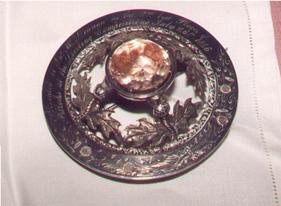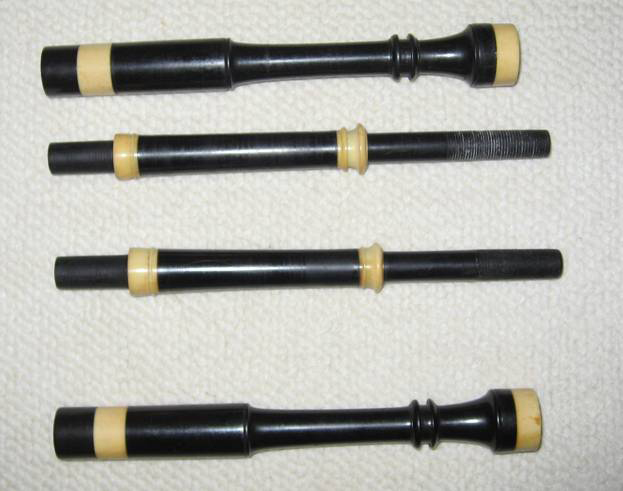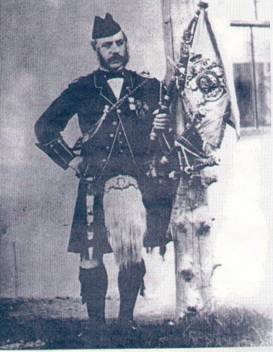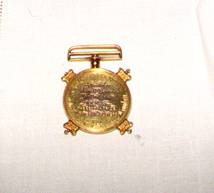By Barry Shears copyright 2011 –
Every bagpipe has a story and in this section we hope to highlight instruments and their known history. If you have access to, or own an antique bagpipe or replica we would be happy to hear from you. So take some photographs and jot down a few lines for posterity.
Previous Owner: John MacLennan, Piper to the Earl of Fife.
Current Owner: Pipe Major George Shears, Calgary Highlanders
Instrument: Reel Pipe. This bellows bagpipe is made from Ebony, with ivory mounts and decorative ivory rings. It has a conical chanter with an ivory sole and a horn and ivory bowl or bulb. The pipes are plainly turned without combing and beading. A curious feature of the common stock is a hardwood disc at the open end of the common stock with a small aperture in the centre to allow air to pass to the drone reeds. I am not sure why this was added, (or installed at the time of manufacture), unless it was used to support the hollowness of the common stock.
When my brother, George, acquired these bagpipes in the 1990s the top section of the bass drone had been broken in two and the top part lost. In 1999 he turned a replica set of drones from African Blackwood on a metal lathe, and a replacement top for the original bagpipe. The chanter was cracked at some point in time and repaired with hemp bindings. As yet no attempt has been made to reed and play the full instrument so this is still very much a work progress.
Maker: Probably Duncan MacDougall, c. 1860. There is no maker’s mark but the style is reminiscent of Duncan MacDougall’s handiwork, and John MacLennan’s Highland bagpipe was also made by Duncan MacDougall. Duncan MacDougall was a member of a well respected Scottish pipe making family which spanned four generations. The MacDougall pipe making dynasty began with Duncan’s grandfather, Allan MacDougall, in the 1790s and continued into the early part of the 20th century with Duncan’s two sons: John and Gavin. (Highland Bagpipe Makers, Campbell, 2011). A price list for Duncan MacDougall shows two varieties of Reel pipes for sale – mouth blown and bellows blown, the price for a set of MacDougall reel pipes with bellows is £5.10.
Historical Background: John MacLennan (c. 1817- 1906), was a member of the famous Scottish piping family of the same name. He was one of two piping sons of Donald Mor MacLennan, Moy, the other son being Pipe Major Sandy MacLennan (c. 1811-1900). Donald Mor MacLennan’s father, Duncan, was a piper at the Battle of Waterloo (1815) and his grand father, Murdoch MacLennan, had been a piper at the Battle of Culloden (1746). Duncan MacLennan was a student of Angus MacKay of Gairloch, whose son John Roy MacKay had immigrated to Nova Scotia in 1805 bringing with him Iain Dall MacKay’s 17th century pipe chanter. (see John G. Gibson article) In addition to the teacher / pupil relationship with the MacKays of Gairloch. Duncan’s brother was married to Angus MacKay’s daughter so the families were further intertwined through family connections. Donald Mor MacLennan was also an uncle of Lt. John McLennan, father of the famous player and composer, G. S. MacLennan.
Donald Mor MacLennan taught several famous 19th pipers including Sandy Cameron and John Ban MacKenzie. (For more detailed information on the MacLennan pipers see Bridget MacKenzie, The Piping Traditions of the North of Scotland, Edinburgh: John Donald Publishers Ltd, 1998). It is not known when Donald Mor died but his son, Sandy and John continued their piping studies with two of their father’s most successful students. Sandy MacLennan went to Sandy Cameron for lessons and won the Inverness Prize Pipe in 1857 and the Gold Medal in 1860 and was later Pipe Major of the Inverness-shire Militia. Pipe Major Sandy MacLennan was also a successful reed maker in the 19th century.
John MacLennan received additional tuition from John BanMacKenzie, and he won the
Prize Pipe in 1848 and the Gold Medal in 1858. (MacKenzie, Piping Traditions, pages 78-79) John MacLennan was piper to the Earl of Fife and in that capacity no doubt played these bellow pipes at social dances on the estate from time to time. Providing music for social dancing appears to have been a frequent function of the top pipers in Scotland particularly in the 19th century, and especially for those pipers attached to large estates. Bellows pipes were the preferred instruments for long evenings of dancing because they could be played for extended periods of time without re-tuning.

Presented to John McLennan as the 2nd best player of Pibroch at the Stirling Competition July 20 1866
John MacLennan’s grandson immigrated to Canada and before John died in 1906, he sent many of his personal effects and awards, including his Gold Medal and this bagpipe to him.
Pipe Major Sandy MacLennan’s Gold Medal also ended up in Canada. Sandy’s only daughter, Catherine, immigrated to Nova Scotia with her husband, Kenneth MacKenzie Baillie, in 1903 shortly after her father’s death. She brought with her several of her father’s awards including the Gold Medal, the Prize Pipe and numerous awards and accoutrements such as a prize dirk. The GoldMedal
was on display in a small local museum in Pictou County in the 1970s, but its current whereabouts are unknown. It might have fallen victim to the rising cost of gold and may have been melted down for its precious metal value.
Although piping died out in John MacLennan’s family in Canada, it continued in Sandy’s MacLennan’s family for another two generations.
Catherine, like her husband and son, and several of their grandchildren were multi-instrumentalists. Catherine played the bagpipe and piano, her husband, known locally as Major Baillie, played Highland pipes, violin, and Uillean pipes and toured throughout North America as a Vaudeville musician in the years prior to the First World War. Catherine’s son, Sandy played pipes and violin, and Sandy’ two sons played several instruments including violin and banjo.
Both Catherine and her husband taught piping in North Eastern Nova Scotia during the first two decades of the 20th century and they proved to be a major musical influence in Nova Scotia through their own teaching and through that of two of their students, Alex Sutherland in North Eastern Nova Scotia and Roddie Nicholson, Cape Breton (Barry Shears, Dance to the Piper, Sydney: Cape Breton University Press, 2008)
The late 20th century saw an increase not only in the number of pipers world wide, but also the number of Highland pipers performing on other instruments beside the Highland bagpipe. The cyclical interest in folk music, which stemmed largely from the folk music revival of the 1970s and bands such as The Bothy Band, The Chieftains, The Battlefield Band and the Tannahill Weavers has offered a tradition almost entirely competitive in structure a chance to expand its horizons. History has come full circle once again and interest is growing not only in the type of bagpipe music played in the 19th century but also the instruments used. If the Reel pipe featured in this article is the work of Duncan MacDougall then it is a fine example of a mid to late 19th century instrument by one of the leading pipe makers of his generation.
.




